The Impact of Food Environment on Obesity: A Public Health Perspective
VerifiedAdded on 2021/06/14
|9
|3839
|41
Report
AI Summary
This report provides a comprehensive analysis of obesity and its determinants, emphasizing the critical role of the food environment. It delves into the definition of health according to WHO, public health principles, and the alarming rise of obesity, particularly in the UK, highlighting its economic and health burdens. The report explores various health determinants, including social, economic, and physical environments, and their influence on obesity. It examines the impact of fast-food outlets, unhealthy diets, and lack of physical activity, while also discussing health inequalities related to income, social deprivation, and ethnicity. The report suggests policy implementations, such as strategies for healthier food provisions, and discusses the importance of healthcare access and health needs assessments. It also covers interventions for children and adults, emphasizing the need for a holistic approach to improve public health and prevent obesity-related diseases. The report highlights the need for a multi-faceted approach, involving policy changes, community engagement, and individual behavior modifications, to create a healthier food environment and reduce the prevalence of obesity.
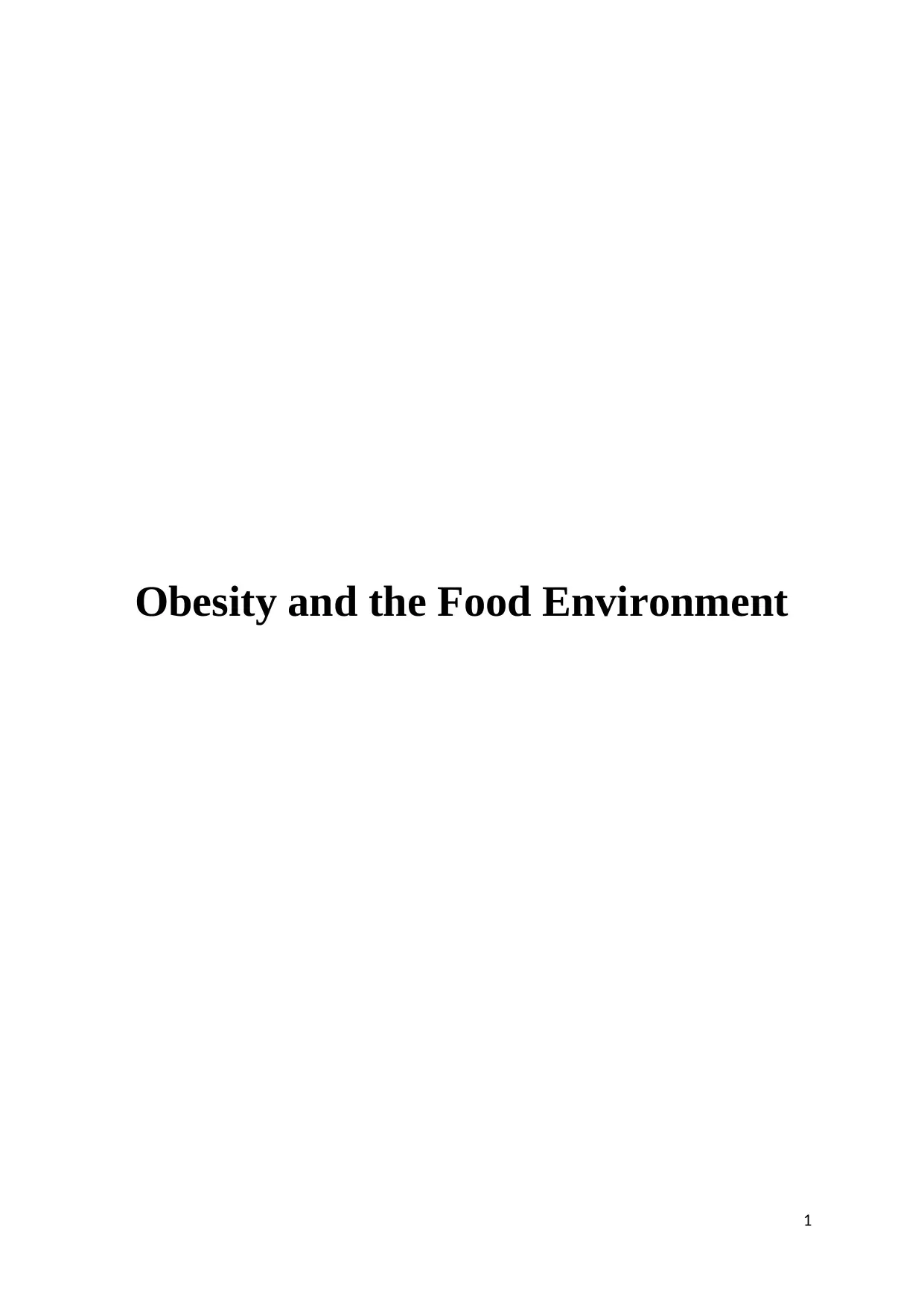
Obesity and the Food Environment
1
1
Paraphrase This Document
Need a fresh take? Get an instant paraphrase of this document with our AI Paraphraser
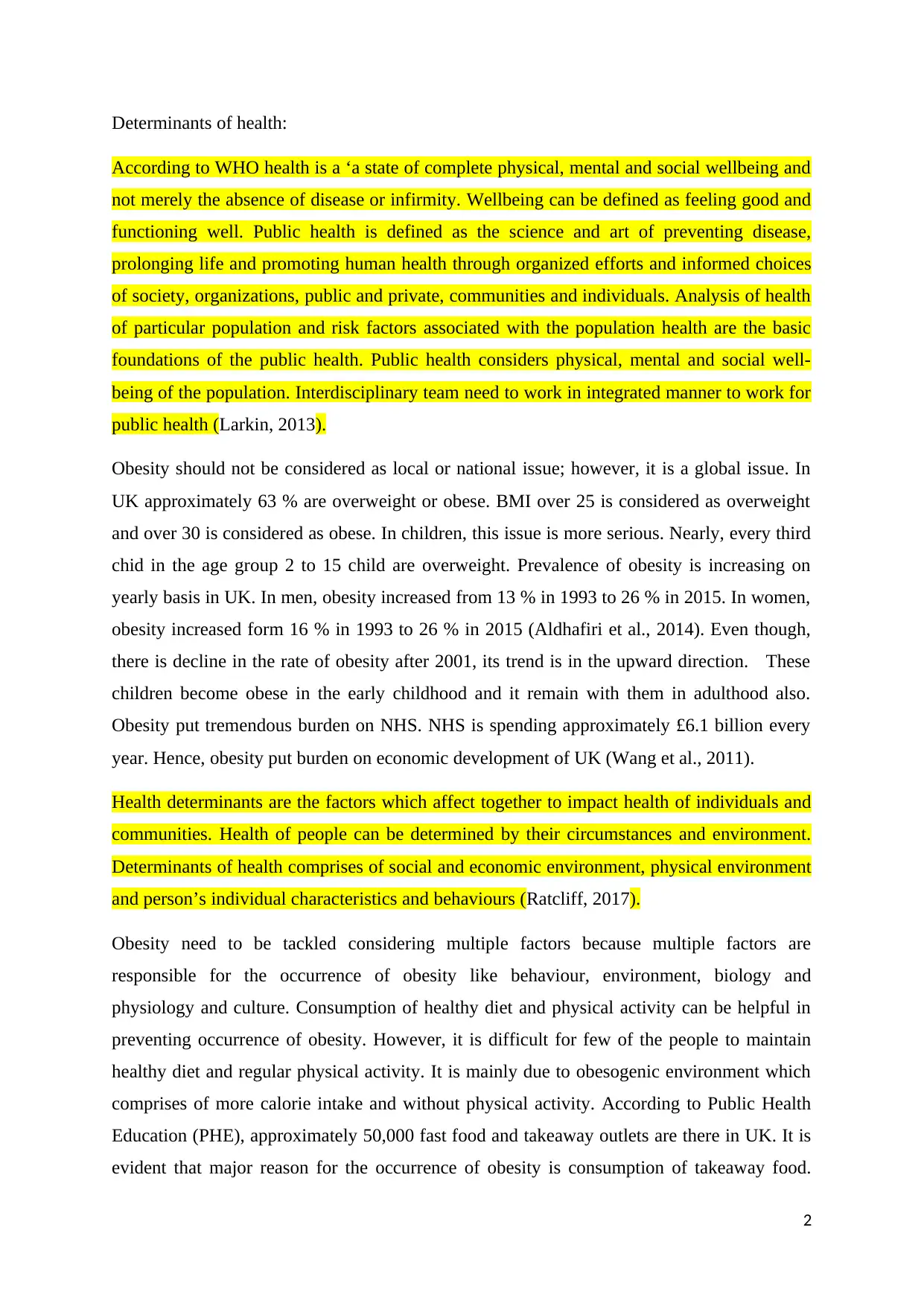
Determinants of health:
According to WHO health is a ‘a state of complete physical, mental and social wellbeing and
not merely the absence of disease or infirmity. Wellbeing can be defined as feeling good and
functioning well. Public health is defined as the science and art of preventing disease,
prolonging life and promoting human health through organized efforts and informed choices
of society, organizations, public and private, communities and individuals. Analysis of health
of particular population and risk factors associated with the population health are the basic
foundations of the public health. Public health considers physical, mental and social well-
being of the population. Interdisciplinary team need to work in integrated manner to work for
public health (Larkin, 2013).
Obesity should not be considered as local or national issue; however, it is a global issue. In
UK approximately 63 % are overweight or obese. BMI over 25 is considered as overweight
and over 30 is considered as obese. In children, this issue is more serious. Nearly, every third
chid in the age group 2 to 15 child are overweight. Prevalence of obesity is increasing on
yearly basis in UK. In men, obesity increased from 13 % in 1993 to 26 % in 2015. In women,
obesity increased form 16 % in 1993 to 26 % in 2015 (Aldhafiri et al., 2014). Even though,
there is decline in the rate of obesity after 2001, its trend is in the upward direction. These
children become obese in the early childhood and it remain with them in adulthood also.
Obesity put tremendous burden on NHS. NHS is spending approximately £6.1 billion every
year. Hence, obesity put burden on economic development of UK (Wang et al., 2011).
Health determinants are the factors which affect together to impact health of individuals and
communities. Health of people can be determined by their circumstances and environment.
Determinants of health comprises of social and economic environment, physical environment
and person’s individual characteristics and behaviours (Ratcliff, 2017).
Obesity need to be tackled considering multiple factors because multiple factors are
responsible for the occurrence of obesity like behaviour, environment, biology and
physiology and culture. Consumption of healthy diet and physical activity can be helpful in
preventing occurrence of obesity. However, it is difficult for few of the people to maintain
healthy diet and regular physical activity. It is mainly due to obesogenic environment which
comprises of more calorie intake and without physical activity. According to Public Health
Education (PHE), approximately 50,000 fast food and takeaway outlets are there in UK. It is
evident that major reason for the occurrence of obesity is consumption of takeaway food.
2
According to WHO health is a ‘a state of complete physical, mental and social wellbeing and
not merely the absence of disease or infirmity. Wellbeing can be defined as feeling good and
functioning well. Public health is defined as the science and art of preventing disease,
prolonging life and promoting human health through organized efforts and informed choices
of society, organizations, public and private, communities and individuals. Analysis of health
of particular population and risk factors associated with the population health are the basic
foundations of the public health. Public health considers physical, mental and social well-
being of the population. Interdisciplinary team need to work in integrated manner to work for
public health (Larkin, 2013).
Obesity should not be considered as local or national issue; however, it is a global issue. In
UK approximately 63 % are overweight or obese. BMI over 25 is considered as overweight
and over 30 is considered as obese. In children, this issue is more serious. Nearly, every third
chid in the age group 2 to 15 child are overweight. Prevalence of obesity is increasing on
yearly basis in UK. In men, obesity increased from 13 % in 1993 to 26 % in 2015. In women,
obesity increased form 16 % in 1993 to 26 % in 2015 (Aldhafiri et al., 2014). Even though,
there is decline in the rate of obesity after 2001, its trend is in the upward direction. These
children become obese in the early childhood and it remain with them in adulthood also.
Obesity put tremendous burden on NHS. NHS is spending approximately £6.1 billion every
year. Hence, obesity put burden on economic development of UK (Wang et al., 2011).
Health determinants are the factors which affect together to impact health of individuals and
communities. Health of people can be determined by their circumstances and environment.
Determinants of health comprises of social and economic environment, physical environment
and person’s individual characteristics and behaviours (Ratcliff, 2017).
Obesity need to be tackled considering multiple factors because multiple factors are
responsible for the occurrence of obesity like behaviour, environment, biology and
physiology and culture. Consumption of healthy diet and physical activity can be helpful in
preventing occurrence of obesity. However, it is difficult for few of the people to maintain
healthy diet and regular physical activity. It is mainly due to obesogenic environment which
comprises of more calorie intake and without physical activity. According to Public Health
Education (PHE), approximately 50,000 fast food and takeaway outlets are there in UK. It is
evident that major reason for the occurrence of obesity is consumption of takeaway food.
2
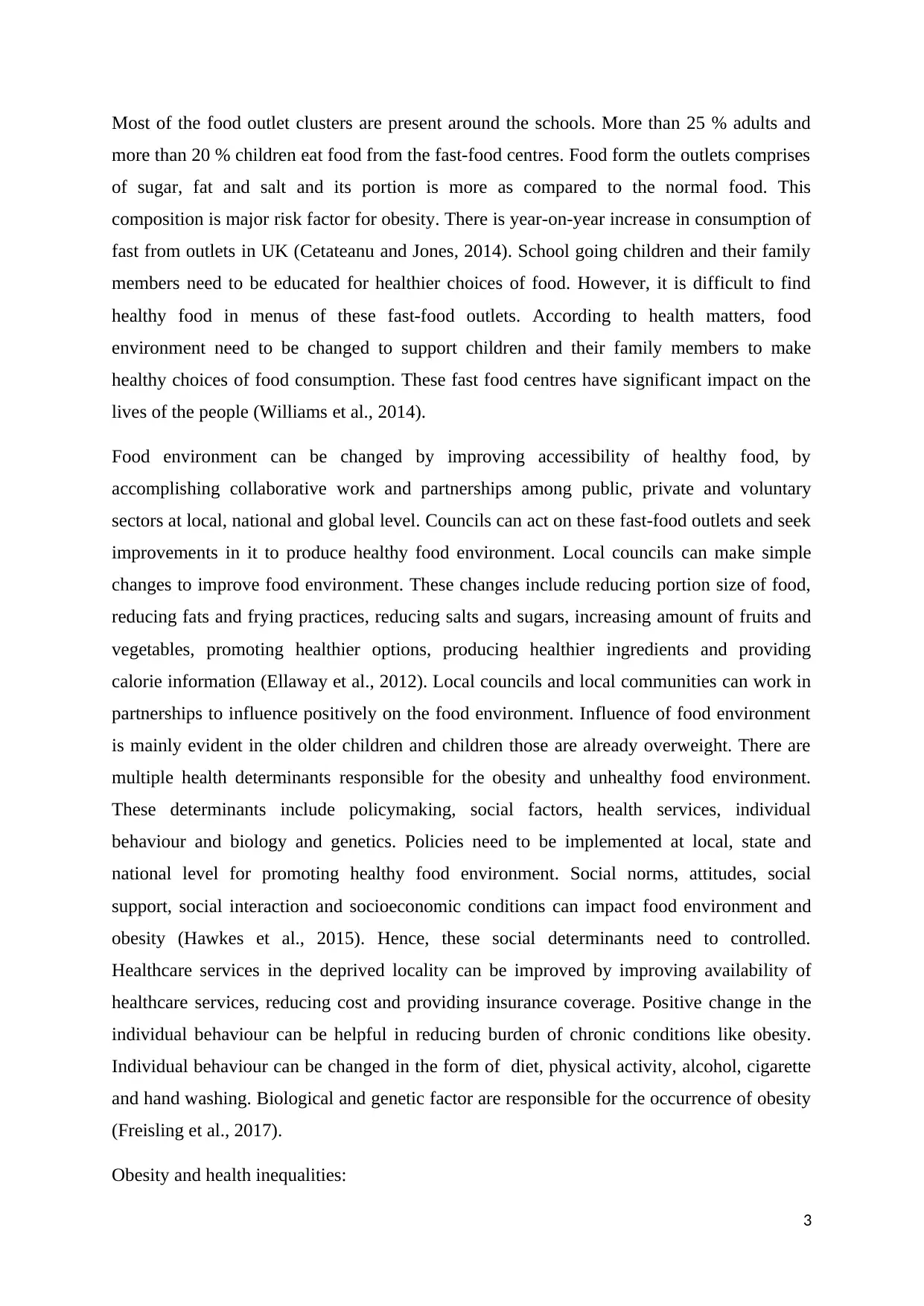
Most of the food outlet clusters are present around the schools. More than 25 % adults and
more than 20 % children eat food from the fast-food centres. Food form the outlets comprises
of sugar, fat and salt and its portion is more as compared to the normal food. This
composition is major risk factor for obesity. There is year-on-year increase in consumption of
fast from outlets in UK (Cetateanu and Jones, 2014). School going children and their family
members need to be educated for healthier choices of food. However, it is difficult to find
healthy food in menus of these fast-food outlets. According to health matters, food
environment need to be changed to support children and their family members to make
healthy choices of food consumption. These fast food centres have significant impact on the
lives of the people (Williams et al., 2014).
Food environment can be changed by improving accessibility of healthy food, by
accomplishing collaborative work and partnerships among public, private and voluntary
sectors at local, national and global level. Councils can act on these fast-food outlets and seek
improvements in it to produce healthy food environment. Local councils can make simple
changes to improve food environment. These changes include reducing portion size of food,
reducing fats and frying practices, reducing salts and sugars, increasing amount of fruits and
vegetables, promoting healthier options, producing healthier ingredients and providing
calorie information (Ellaway et al., 2012). Local councils and local communities can work in
partnerships to influence positively on the food environment. Influence of food environment
is mainly evident in the older children and children those are already overweight. There are
multiple health determinants responsible for the obesity and unhealthy food environment.
These determinants include policymaking, social factors, health services, individual
behaviour and biology and genetics. Policies need to be implemented at local, state and
national level for promoting healthy food environment. Social norms, attitudes, social
support, social interaction and socioeconomic conditions can impact food environment and
obesity (Hawkes et al., 2015). Hence, these social determinants need to controlled.
Healthcare services in the deprived locality can be improved by improving availability of
healthcare services, reducing cost and providing insurance coverage. Positive change in the
individual behaviour can be helpful in reducing burden of chronic conditions like obesity.
Individual behaviour can be changed in the form of diet, physical activity, alcohol, cigarette
and hand washing. Biological and genetic factor are responsible for the occurrence of obesity
(Freisling et al., 2017).
Obesity and health inequalities:
3
more than 20 % children eat food from the fast-food centres. Food form the outlets comprises
of sugar, fat and salt and its portion is more as compared to the normal food. This
composition is major risk factor for obesity. There is year-on-year increase in consumption of
fast from outlets in UK (Cetateanu and Jones, 2014). School going children and their family
members need to be educated for healthier choices of food. However, it is difficult to find
healthy food in menus of these fast-food outlets. According to health matters, food
environment need to be changed to support children and their family members to make
healthy choices of food consumption. These fast food centres have significant impact on the
lives of the people (Williams et al., 2014).
Food environment can be changed by improving accessibility of healthy food, by
accomplishing collaborative work and partnerships among public, private and voluntary
sectors at local, national and global level. Councils can act on these fast-food outlets and seek
improvements in it to produce healthy food environment. Local councils can make simple
changes to improve food environment. These changes include reducing portion size of food,
reducing fats and frying practices, reducing salts and sugars, increasing amount of fruits and
vegetables, promoting healthier options, producing healthier ingredients and providing
calorie information (Ellaway et al., 2012). Local councils and local communities can work in
partnerships to influence positively on the food environment. Influence of food environment
is mainly evident in the older children and children those are already overweight. There are
multiple health determinants responsible for the obesity and unhealthy food environment.
These determinants include policymaking, social factors, health services, individual
behaviour and biology and genetics. Policies need to be implemented at local, state and
national level for promoting healthy food environment. Social norms, attitudes, social
support, social interaction and socioeconomic conditions can impact food environment and
obesity (Hawkes et al., 2015). Hence, these social determinants need to controlled.
Healthcare services in the deprived locality can be improved by improving availability of
healthcare services, reducing cost and providing insurance coverage. Positive change in the
individual behaviour can be helpful in reducing burden of chronic conditions like obesity.
Individual behaviour can be changed in the form of diet, physical activity, alcohol, cigarette
and hand washing. Biological and genetic factor are responsible for the occurrence of obesity
(Freisling et al., 2017).
Obesity and health inequalities:
3
⊘ This is a preview!⊘
Do you want full access?
Subscribe today to unlock all pages.

Trusted by 1+ million students worldwide
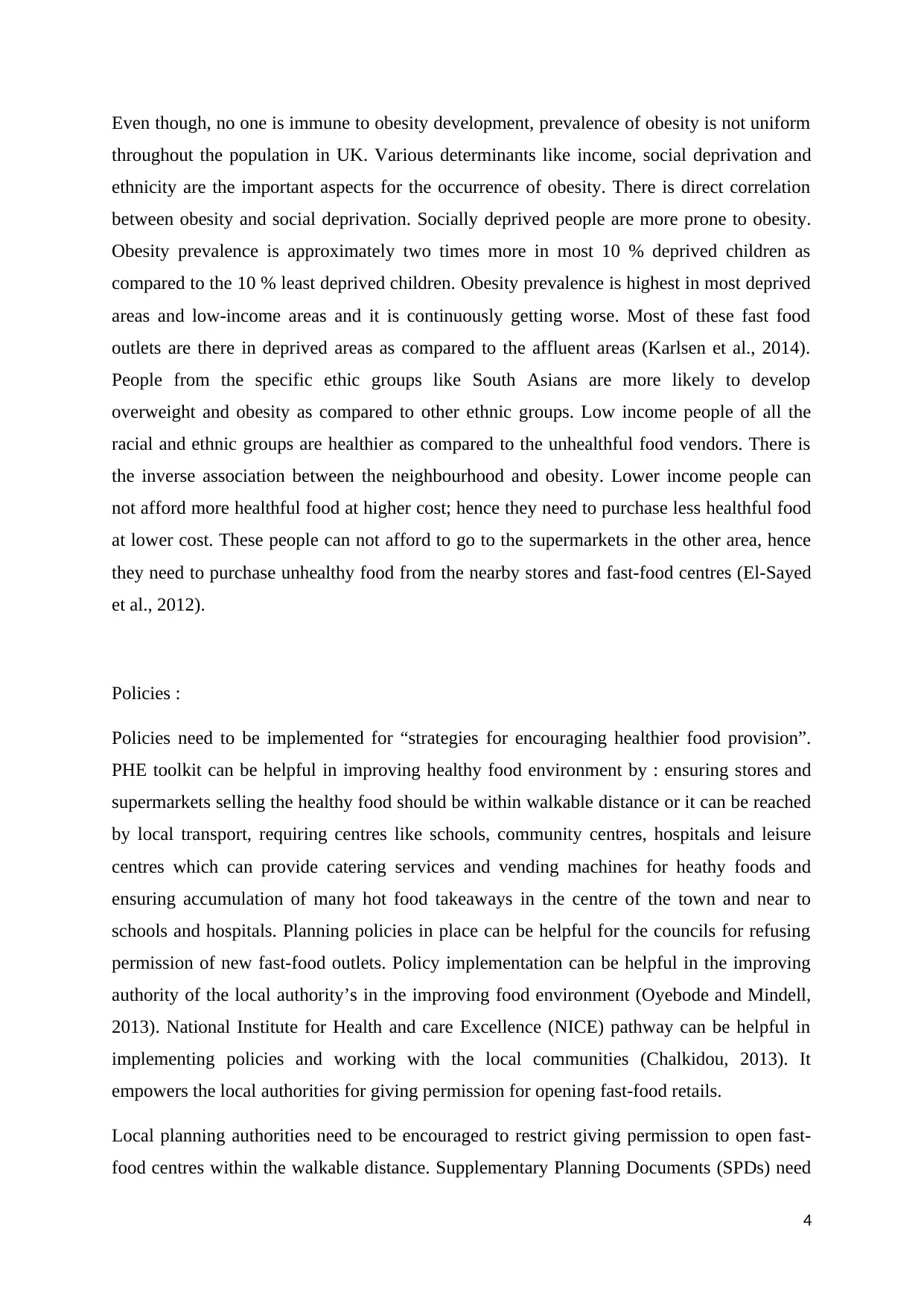
Even though, no one is immune to obesity development, prevalence of obesity is not uniform
throughout the population in UK. Various determinants like income, social deprivation and
ethnicity are the important aspects for the occurrence of obesity. There is direct correlation
between obesity and social deprivation. Socially deprived people are more prone to obesity.
Obesity prevalence is approximately two times more in most 10 % deprived children as
compared to the 10 % least deprived children. Obesity prevalence is highest in most deprived
areas and low-income areas and it is continuously getting worse. Most of these fast food
outlets are there in deprived areas as compared to the affluent areas (Karlsen et al., 2014).
People from the specific ethic groups like South Asians are more likely to develop
overweight and obesity as compared to other ethnic groups. Low income people of all the
racial and ethnic groups are healthier as compared to the unhealthful food vendors. There is
the inverse association between the neighbourhood and obesity. Lower income people can
not afford more healthful food at higher cost; hence they need to purchase less healthful food
at lower cost. These people can not afford to go to the supermarkets in the other area, hence
they need to purchase unhealthy food from the nearby stores and fast-food centres (El-Sayed
et al., 2012).
Policies :
Policies need to be implemented for “strategies for encouraging healthier food provision”.
PHE toolkit can be helpful in improving healthy food environment by : ensuring stores and
supermarkets selling the healthy food should be within walkable distance or it can be reached
by local transport, requiring centres like schools, community centres, hospitals and leisure
centres which can provide catering services and vending machines for heathy foods and
ensuring accumulation of many hot food takeaways in the centre of the town and near to
schools and hospitals. Planning policies in place can be helpful for the councils for refusing
permission of new fast-food outlets. Policy implementation can be helpful in the improving
authority of the local authority’s in the improving food environment (Oyebode and Mindell,
2013). National Institute for Health and care Excellence (NICE) pathway can be helpful in
implementing policies and working with the local communities (Chalkidou, 2013). It
empowers the local authorities for giving permission for opening fast-food retails.
Local planning authorities need to be encouraged to restrict giving permission to open fast-
food centres within the walkable distance. Supplementary Planning Documents (SPDs) need
4
throughout the population in UK. Various determinants like income, social deprivation and
ethnicity are the important aspects for the occurrence of obesity. There is direct correlation
between obesity and social deprivation. Socially deprived people are more prone to obesity.
Obesity prevalence is approximately two times more in most 10 % deprived children as
compared to the 10 % least deprived children. Obesity prevalence is highest in most deprived
areas and low-income areas and it is continuously getting worse. Most of these fast food
outlets are there in deprived areas as compared to the affluent areas (Karlsen et al., 2014).
People from the specific ethic groups like South Asians are more likely to develop
overweight and obesity as compared to other ethnic groups. Low income people of all the
racial and ethnic groups are healthier as compared to the unhealthful food vendors. There is
the inverse association between the neighbourhood and obesity. Lower income people can
not afford more healthful food at higher cost; hence they need to purchase less healthful food
at lower cost. These people can not afford to go to the supermarkets in the other area, hence
they need to purchase unhealthy food from the nearby stores and fast-food centres (El-Sayed
et al., 2012).
Policies :
Policies need to be implemented for “strategies for encouraging healthier food provision”.
PHE toolkit can be helpful in improving healthy food environment by : ensuring stores and
supermarkets selling the healthy food should be within walkable distance or it can be reached
by local transport, requiring centres like schools, community centres, hospitals and leisure
centres which can provide catering services and vending machines for heathy foods and
ensuring accumulation of many hot food takeaways in the centre of the town and near to
schools and hospitals. Planning policies in place can be helpful for the councils for refusing
permission of new fast-food outlets. Policy implementation can be helpful in the improving
authority of the local authority’s in the improving food environment (Oyebode and Mindell,
2013). National Institute for Health and care Excellence (NICE) pathway can be helpful in
implementing policies and working with the local communities (Chalkidou, 2013). It
empowers the local authorities for giving permission for opening fast-food retails.
Local planning authorities need to be encouraged to restrict giving permission to open fast-
food centres within the walkable distance. Supplementary Planning Documents (SPDs) need
4
Paraphrase This Document
Need a fresh take? Get an instant paraphrase of this document with our AI Paraphraser
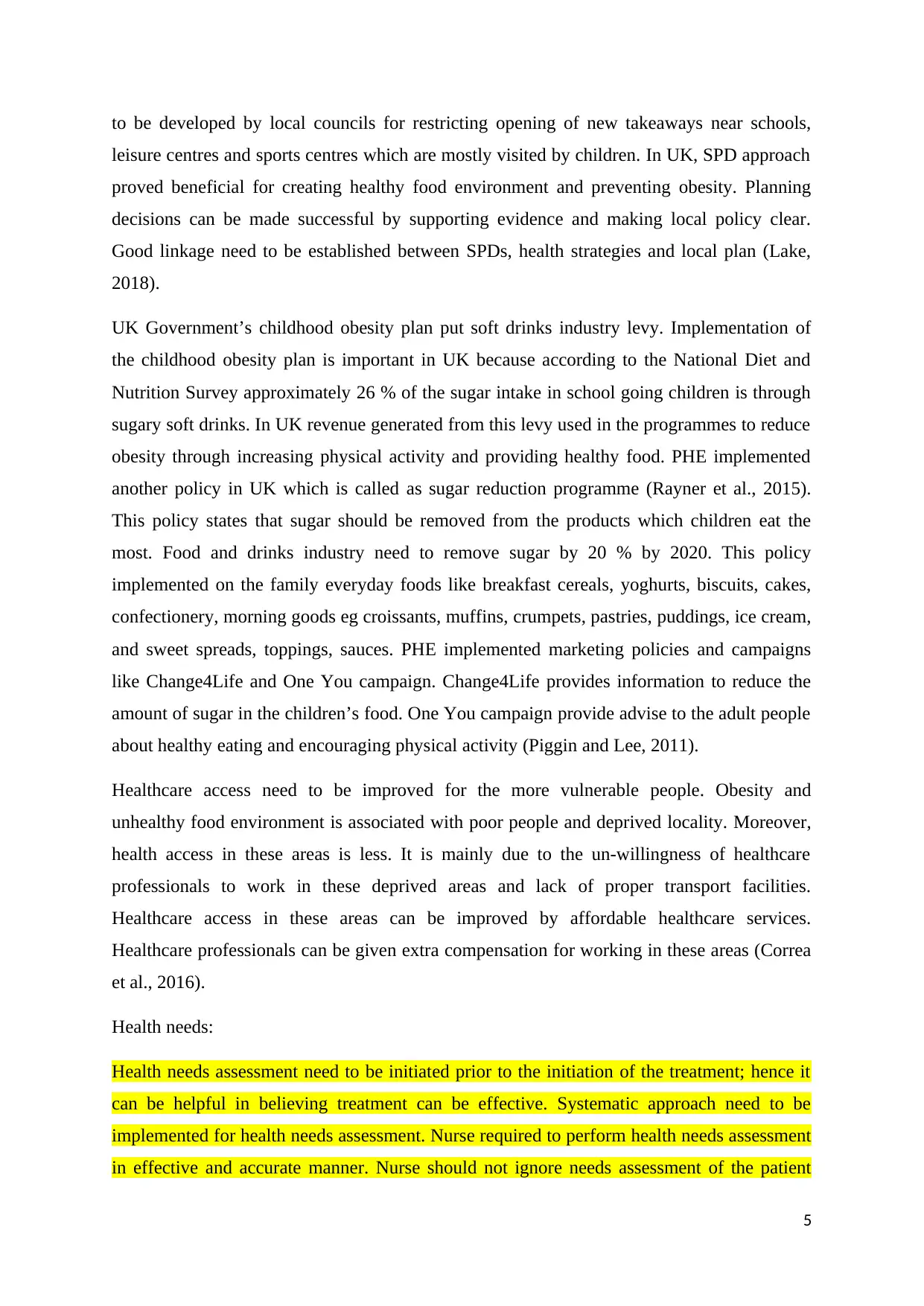
to be developed by local councils for restricting opening of new takeaways near schools,
leisure centres and sports centres which are mostly visited by children. In UK, SPD approach
proved beneficial for creating healthy food environment and preventing obesity. Planning
decisions can be made successful by supporting evidence and making local policy clear.
Good linkage need to be established between SPDs, health strategies and local plan (Lake,
2018).
UK Government’s childhood obesity plan put soft drinks industry levy. Implementation of
the childhood obesity plan is important in UK because according to the National Diet and
Nutrition Survey approximately 26 % of the sugar intake in school going children is through
sugary soft drinks. In UK revenue generated from this levy used in the programmes to reduce
obesity through increasing physical activity and providing healthy food. PHE implemented
another policy in UK which is called as sugar reduction programme (Rayner et al., 2015).
This policy states that sugar should be removed from the products which children eat the
most. Food and drinks industry need to remove sugar by 20 % by 2020. This policy
implemented on the family everyday foods like breakfast cereals, yoghurts, biscuits, cakes,
confectionery, morning goods eg croissants, muffins, crumpets, pastries, puddings, ice cream,
and sweet spreads, toppings, sauces. PHE implemented marketing policies and campaigns
like Change4Life and One You campaign. Change4Life provides information to reduce the
amount of sugar in the children’s food. One You campaign provide advise to the adult people
about healthy eating and encouraging physical activity (Piggin and Lee, 2011).
Healthcare access need to be improved for the more vulnerable people. Obesity and
unhealthy food environment is associated with poor people and deprived locality. Moreover,
health access in these areas is less. It is mainly due to the un-willingness of healthcare
professionals to work in these deprived areas and lack of proper transport facilities.
Healthcare access in these areas can be improved by affordable healthcare services.
Healthcare professionals can be given extra compensation for working in these areas (Correa
et al., 2016).
Health needs:
Health needs assessment need to be initiated prior to the initiation of the treatment; hence it
can be helpful in believing treatment can be effective. Systematic approach need to be
implemented for health needs assessment. Nurse required to perform health needs assessment
in effective and accurate manner. Nurse should not ignore needs assessment of the patient
5
leisure centres and sports centres which are mostly visited by children. In UK, SPD approach
proved beneficial for creating healthy food environment and preventing obesity. Planning
decisions can be made successful by supporting evidence and making local policy clear.
Good linkage need to be established between SPDs, health strategies and local plan (Lake,
2018).
UK Government’s childhood obesity plan put soft drinks industry levy. Implementation of
the childhood obesity plan is important in UK because according to the National Diet and
Nutrition Survey approximately 26 % of the sugar intake in school going children is through
sugary soft drinks. In UK revenue generated from this levy used in the programmes to reduce
obesity through increasing physical activity and providing healthy food. PHE implemented
another policy in UK which is called as sugar reduction programme (Rayner et al., 2015).
This policy states that sugar should be removed from the products which children eat the
most. Food and drinks industry need to remove sugar by 20 % by 2020. This policy
implemented on the family everyday foods like breakfast cereals, yoghurts, biscuits, cakes,
confectionery, morning goods eg croissants, muffins, crumpets, pastries, puddings, ice cream,
and sweet spreads, toppings, sauces. PHE implemented marketing policies and campaigns
like Change4Life and One You campaign. Change4Life provides information to reduce the
amount of sugar in the children’s food. One You campaign provide advise to the adult people
about healthy eating and encouraging physical activity (Piggin and Lee, 2011).
Healthcare access need to be improved for the more vulnerable people. Obesity and
unhealthy food environment is associated with poor people and deprived locality. Moreover,
health access in these areas is less. It is mainly due to the un-willingness of healthcare
professionals to work in these deprived areas and lack of proper transport facilities.
Healthcare access in these areas can be improved by affordable healthcare services.
Healthcare professionals can be given extra compensation for working in these areas (Correa
et al., 2016).
Health needs:
Health needs assessment need to be initiated prior to the initiation of the treatment; hence it
can be helpful in believing treatment can be effective. Systematic approach need to be
implemented for health needs assessment. Nurse required to perform health needs assessment
in effective and accurate manner. Nurse should not ignore needs assessment of the patient
5
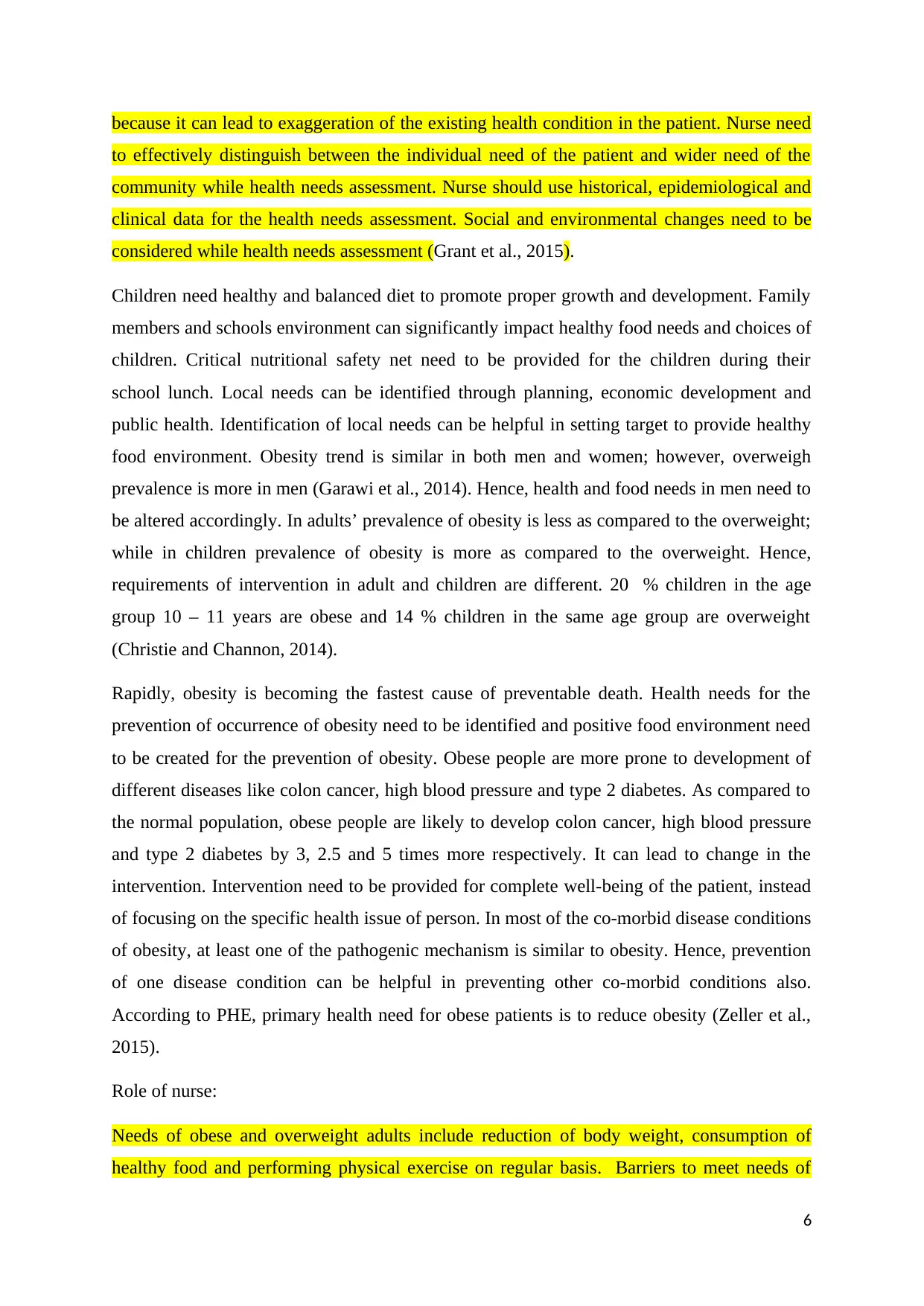
because it can lead to exaggeration of the existing health condition in the patient. Nurse need
to effectively distinguish between the individual need of the patient and wider need of the
community while health needs assessment. Nurse should use historical, epidemiological and
clinical data for the health needs assessment. Social and environmental changes need to be
considered while health needs assessment (Grant et al., 2015).
Children need healthy and balanced diet to promote proper growth and development. Family
members and schools environment can significantly impact healthy food needs and choices of
children. Critical nutritional safety net need to be provided for the children during their
school lunch. Local needs can be identified through planning, economic development and
public health. Identification of local needs can be helpful in setting target to provide healthy
food environment. Obesity trend is similar in both men and women; however, overweigh
prevalence is more in men (Garawi et al., 2014). Hence, health and food needs in men need to
be altered accordingly. In adults’ prevalence of obesity is less as compared to the overweight;
while in children prevalence of obesity is more as compared to the overweight. Hence,
requirements of intervention in adult and children are different. 20 % children in the age
group 10 – 11 years are obese and 14 % children in the same age group are overweight
(Christie and Channon, 2014).
Rapidly, obesity is becoming the fastest cause of preventable death. Health needs for the
prevention of occurrence of obesity need to be identified and positive food environment need
to be created for the prevention of obesity. Obese people are more prone to development of
different diseases like colon cancer, high blood pressure and type 2 diabetes. As compared to
the normal population, obese people are likely to develop colon cancer, high blood pressure
and type 2 diabetes by 3, 2.5 and 5 times more respectively. It can lead to change in the
intervention. Intervention need to be provided for complete well-being of the patient, instead
of focusing on the specific health issue of person. In most of the co-morbid disease conditions
of obesity, at least one of the pathogenic mechanism is similar to obesity. Hence, prevention
of one disease condition can be helpful in preventing other co-morbid conditions also.
According to PHE, primary health need for obese patients is to reduce obesity (Zeller et al.,
2015).
Role of nurse:
Needs of obese and overweight adults include reduction of body weight, consumption of
healthy food and performing physical exercise on regular basis. Barriers to meet needs of
6
to effectively distinguish between the individual need of the patient and wider need of the
community while health needs assessment. Nurse should use historical, epidemiological and
clinical data for the health needs assessment. Social and environmental changes need to be
considered while health needs assessment (Grant et al., 2015).
Children need healthy and balanced diet to promote proper growth and development. Family
members and schools environment can significantly impact healthy food needs and choices of
children. Critical nutritional safety net need to be provided for the children during their
school lunch. Local needs can be identified through planning, economic development and
public health. Identification of local needs can be helpful in setting target to provide healthy
food environment. Obesity trend is similar in both men and women; however, overweigh
prevalence is more in men (Garawi et al., 2014). Hence, health and food needs in men need to
be altered accordingly. In adults’ prevalence of obesity is less as compared to the overweight;
while in children prevalence of obesity is more as compared to the overweight. Hence,
requirements of intervention in adult and children are different. 20 % children in the age
group 10 – 11 years are obese and 14 % children in the same age group are overweight
(Christie and Channon, 2014).
Rapidly, obesity is becoming the fastest cause of preventable death. Health needs for the
prevention of occurrence of obesity need to be identified and positive food environment need
to be created for the prevention of obesity. Obese people are more prone to development of
different diseases like colon cancer, high blood pressure and type 2 diabetes. As compared to
the normal population, obese people are likely to develop colon cancer, high blood pressure
and type 2 diabetes by 3, 2.5 and 5 times more respectively. It can lead to change in the
intervention. Intervention need to be provided for complete well-being of the patient, instead
of focusing on the specific health issue of person. In most of the co-morbid disease conditions
of obesity, at least one of the pathogenic mechanism is similar to obesity. Hence, prevention
of one disease condition can be helpful in preventing other co-morbid conditions also.
According to PHE, primary health need for obese patients is to reduce obesity (Zeller et al.,
2015).
Role of nurse:
Needs of obese and overweight adults include reduction of body weight, consumption of
healthy food and performing physical exercise on regular basis. Barriers to meet needs of
6
⊘ This is a preview!⊘
Do you want full access?
Subscribe today to unlock all pages.

Trusted by 1+ million students worldwide
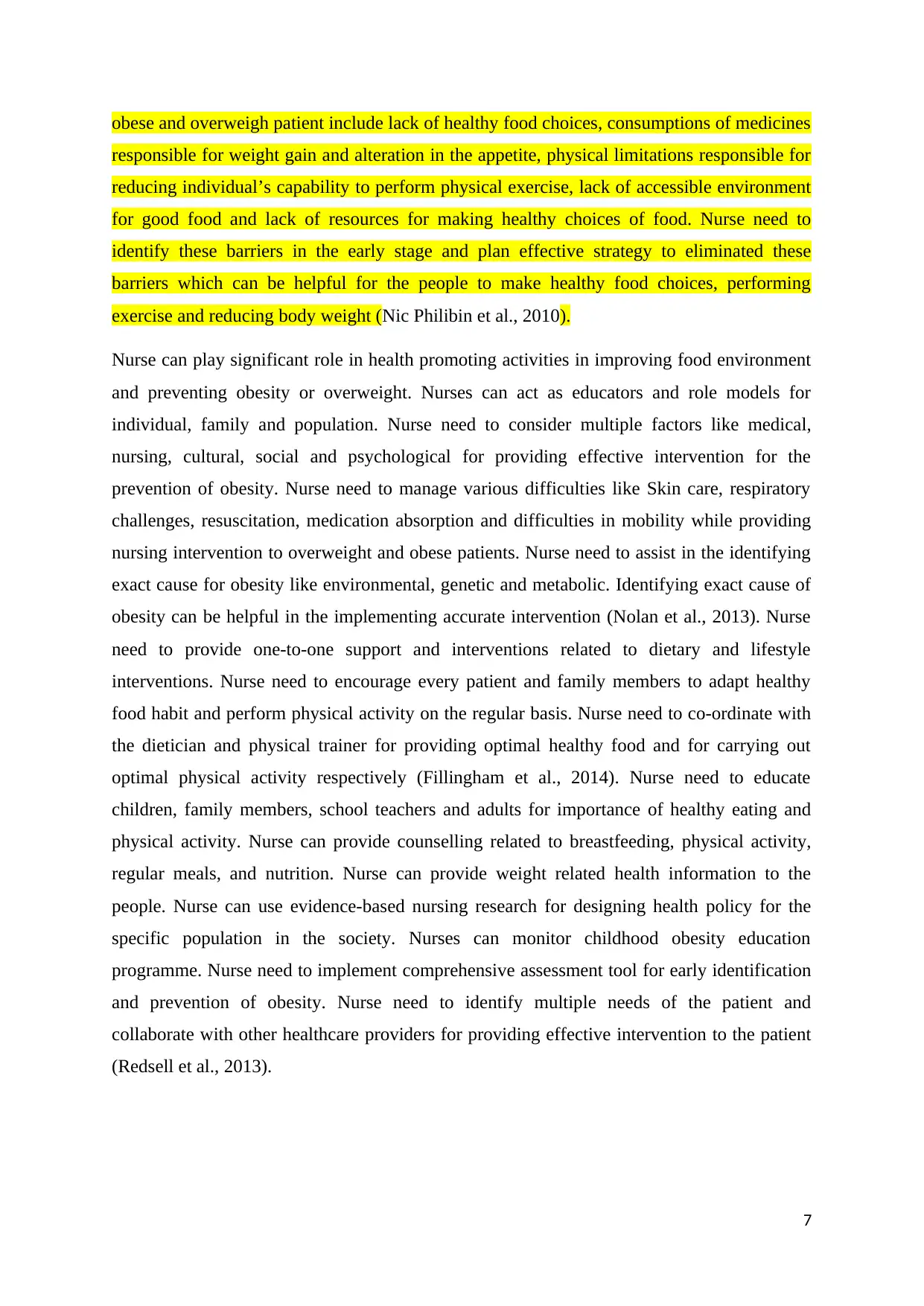
obese and overweigh patient include lack of healthy food choices, consumptions of medicines
responsible for weight gain and alteration in the appetite, physical limitations responsible for
reducing individual’s capability to perform physical exercise, lack of accessible environment
for good food and lack of resources for making healthy choices of food. Nurse need to
identify these barriers in the early stage and plan effective strategy to eliminated these
barriers which can be helpful for the people to make healthy food choices, performing
exercise and reducing body weight (Nic Philibin et al., 2010).
Nurse can play significant role in health promoting activities in improving food environment
and preventing obesity or overweight. Nurses can act as educators and role models for
individual, family and population. Nurse need to consider multiple factors like medical,
nursing, cultural, social and psychological for providing effective intervention for the
prevention of obesity. Nurse need to manage various difficulties like Skin care, respiratory
challenges, resuscitation, medication absorption and difficulties in mobility while providing
nursing intervention to overweight and obese patients. Nurse need to assist in the identifying
exact cause for obesity like environmental, genetic and metabolic. Identifying exact cause of
obesity can be helpful in the implementing accurate intervention (Nolan et al., 2013). Nurse
need to provide one-to-one support and interventions related to dietary and lifestyle
interventions. Nurse need to encourage every patient and family members to adapt healthy
food habit and perform physical activity on the regular basis. Nurse need to co-ordinate with
the dietician and physical trainer for providing optimal healthy food and for carrying out
optimal physical activity respectively (Fillingham et al., 2014). Nurse need to educate
children, family members, school teachers and adults for importance of healthy eating and
physical activity. Nurse can provide counselling related to breastfeeding, physical activity,
regular meals, and nutrition. Nurse can provide weight related health information to the
people. Nurse can use evidence-based nursing research for designing health policy for the
specific population in the society. Nurses can monitor childhood obesity education
programme. Nurse need to implement comprehensive assessment tool for early identification
and prevention of obesity. Nurse need to identify multiple needs of the patient and
collaborate with other healthcare providers for providing effective intervention to the patient
(Redsell et al., 2013).
7
responsible for weight gain and alteration in the appetite, physical limitations responsible for
reducing individual’s capability to perform physical exercise, lack of accessible environment
for good food and lack of resources for making healthy choices of food. Nurse need to
identify these barriers in the early stage and plan effective strategy to eliminated these
barriers which can be helpful for the people to make healthy food choices, performing
exercise and reducing body weight (Nic Philibin et al., 2010).
Nurse can play significant role in health promoting activities in improving food environment
and preventing obesity or overweight. Nurses can act as educators and role models for
individual, family and population. Nurse need to consider multiple factors like medical,
nursing, cultural, social and psychological for providing effective intervention for the
prevention of obesity. Nurse need to manage various difficulties like Skin care, respiratory
challenges, resuscitation, medication absorption and difficulties in mobility while providing
nursing intervention to overweight and obese patients. Nurse need to assist in the identifying
exact cause for obesity like environmental, genetic and metabolic. Identifying exact cause of
obesity can be helpful in the implementing accurate intervention (Nolan et al., 2013). Nurse
need to provide one-to-one support and interventions related to dietary and lifestyle
interventions. Nurse need to encourage every patient and family members to adapt healthy
food habit and perform physical activity on the regular basis. Nurse need to co-ordinate with
the dietician and physical trainer for providing optimal healthy food and for carrying out
optimal physical activity respectively (Fillingham et al., 2014). Nurse need to educate
children, family members, school teachers and adults for importance of healthy eating and
physical activity. Nurse can provide counselling related to breastfeeding, physical activity,
regular meals, and nutrition. Nurse can provide weight related health information to the
people. Nurse can use evidence-based nursing research for designing health policy for the
specific population in the society. Nurses can monitor childhood obesity education
programme. Nurse need to implement comprehensive assessment tool for early identification
and prevention of obesity. Nurse need to identify multiple needs of the patient and
collaborate with other healthcare providers for providing effective intervention to the patient
(Redsell et al., 2013).
7
Paraphrase This Document
Need a fresh take? Get an instant paraphrase of this document with our AI Paraphraser
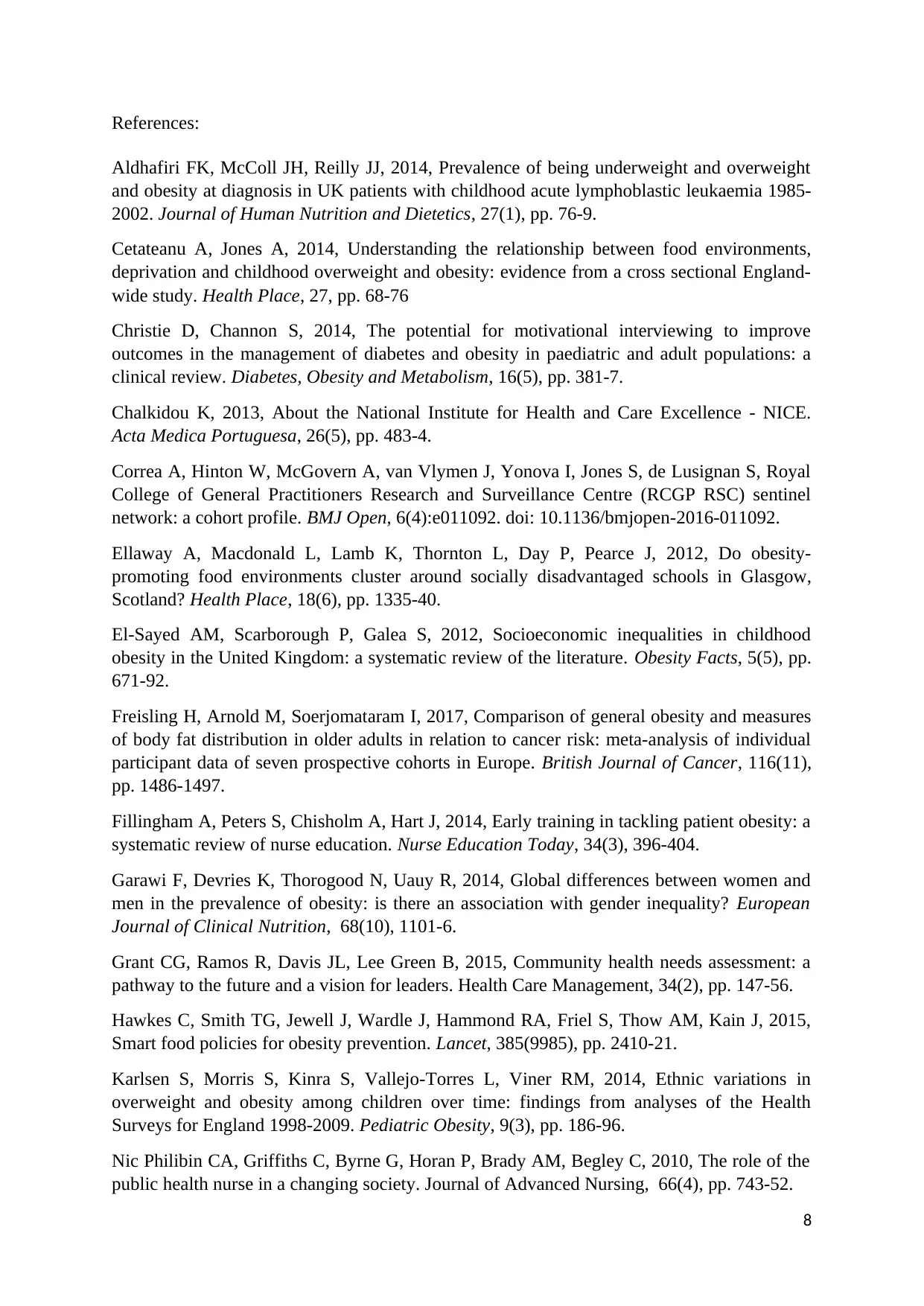
References:
Aldhafiri FK, McColl JH, Reilly JJ, 2014, Prevalence of being underweight and overweight
and obesity at diagnosis in UK patients with childhood acute lymphoblastic leukaemia 1985-
2002. Journal of Human Nutrition and Dietetics, 27(1), pp. 76-9.
Cetateanu A, Jones A, 2014, Understanding the relationship between food environments,
deprivation and childhood overweight and obesity: evidence from a cross sectional England-
wide study. Health Place, 27, pp. 68-76
Christie D, Channon S, 2014, The potential for motivational interviewing to improve
outcomes in the management of diabetes and obesity in paediatric and adult populations: a
clinical review. Diabetes, Obesity and Metabolism, 16(5), pp. 381-7.
Chalkidou K, 2013, About the National Institute for Health and Care Excellence - NICE.
Acta Medica Portuguesa, 26(5), pp. 483-4.
Correa A, Hinton W, McGovern A, van Vlymen J, Yonova I, Jones S, de Lusignan S, Royal
College of General Practitioners Research and Surveillance Centre (RCGP RSC) sentinel
network: a cohort profile. BMJ Open, 6(4):e011092. doi: 10.1136/bmjopen-2016-011092.
Ellaway A, Macdonald L, Lamb K, Thornton L, Day P, Pearce J, 2012, Do obesity-
promoting food environments cluster around socially disadvantaged schools in Glasgow,
Scotland? Health Place, 18(6), pp. 1335-40.
El-Sayed AM, Scarborough P, Galea S, 2012, Socioeconomic inequalities in childhood
obesity in the United Kingdom: a systematic review of the literature. Obesity Facts, 5(5), pp.
671-92.
Freisling H, Arnold M, Soerjomataram I, 2017, Comparison of general obesity and measures
of body fat distribution in older adults in relation to cancer risk: meta-analysis of individual
participant data of seven prospective cohorts in Europe. British Journal of Cancer, 116(11),
pp. 1486-1497.
Fillingham A, Peters S, Chisholm A, Hart J, 2014, Early training in tackling patient obesity: a
systematic review of nurse education. Nurse Education Today, 34(3), 396-404.
Garawi F, Devries K, Thorogood N, Uauy R, 2014, Global differences between women and
men in the prevalence of obesity: is there an association with gender inequality? European
Journal of Clinical Nutrition, 68(10), 1101-6.
Grant CG, Ramos R, Davis JL, Lee Green B, 2015, Community health needs assessment: a
pathway to the future and a vision for leaders. Health Care Management, 34(2), pp. 147-56.
Hawkes C, Smith TG, Jewell J, Wardle J, Hammond RA, Friel S, Thow AM, Kain J, 2015,
Smart food policies for obesity prevention. Lancet, 385(9985), pp. 2410-21.
Karlsen S, Morris S, Kinra S, Vallejo-Torres L, Viner RM, 2014, Ethnic variations in
overweight and obesity among children over time: findings from analyses of the Health
Surveys for England 1998-2009. Pediatric Obesity, 9(3), pp. 186-96.
Nic Philibin CA, Griffiths C, Byrne G, Horan P, Brady AM, Begley C, 2010, The role of the
public health nurse in a changing society. Journal of Advanced Nursing, 66(4), pp. 743-52.
8
Aldhafiri FK, McColl JH, Reilly JJ, 2014, Prevalence of being underweight and overweight
and obesity at diagnosis in UK patients with childhood acute lymphoblastic leukaemia 1985-
2002. Journal of Human Nutrition and Dietetics, 27(1), pp. 76-9.
Cetateanu A, Jones A, 2014, Understanding the relationship between food environments,
deprivation and childhood overweight and obesity: evidence from a cross sectional England-
wide study. Health Place, 27, pp. 68-76
Christie D, Channon S, 2014, The potential for motivational interviewing to improve
outcomes in the management of diabetes and obesity in paediatric and adult populations: a
clinical review. Diabetes, Obesity and Metabolism, 16(5), pp. 381-7.
Chalkidou K, 2013, About the National Institute for Health and Care Excellence - NICE.
Acta Medica Portuguesa, 26(5), pp. 483-4.
Correa A, Hinton W, McGovern A, van Vlymen J, Yonova I, Jones S, de Lusignan S, Royal
College of General Practitioners Research and Surveillance Centre (RCGP RSC) sentinel
network: a cohort profile. BMJ Open, 6(4):e011092. doi: 10.1136/bmjopen-2016-011092.
Ellaway A, Macdonald L, Lamb K, Thornton L, Day P, Pearce J, 2012, Do obesity-
promoting food environments cluster around socially disadvantaged schools in Glasgow,
Scotland? Health Place, 18(6), pp. 1335-40.
El-Sayed AM, Scarborough P, Galea S, 2012, Socioeconomic inequalities in childhood
obesity in the United Kingdom: a systematic review of the literature. Obesity Facts, 5(5), pp.
671-92.
Freisling H, Arnold M, Soerjomataram I, 2017, Comparison of general obesity and measures
of body fat distribution in older adults in relation to cancer risk: meta-analysis of individual
participant data of seven prospective cohorts in Europe. British Journal of Cancer, 116(11),
pp. 1486-1497.
Fillingham A, Peters S, Chisholm A, Hart J, 2014, Early training in tackling patient obesity: a
systematic review of nurse education. Nurse Education Today, 34(3), 396-404.
Garawi F, Devries K, Thorogood N, Uauy R, 2014, Global differences between women and
men in the prevalence of obesity: is there an association with gender inequality? European
Journal of Clinical Nutrition, 68(10), 1101-6.
Grant CG, Ramos R, Davis JL, Lee Green B, 2015, Community health needs assessment: a
pathway to the future and a vision for leaders. Health Care Management, 34(2), pp. 147-56.
Hawkes C, Smith TG, Jewell J, Wardle J, Hammond RA, Friel S, Thow AM, Kain J, 2015,
Smart food policies for obesity prevention. Lancet, 385(9985), pp. 2410-21.
Karlsen S, Morris S, Kinra S, Vallejo-Torres L, Viner RM, 2014, Ethnic variations in
overweight and obesity among children over time: findings from analyses of the Health
Surveys for England 1998-2009. Pediatric Obesity, 9(3), pp. 186-96.
Nic Philibin CA, Griffiths C, Byrne G, Horan P, Brady AM, Begley C, 2010, The role of the
public health nurse in a changing society. Journal of Advanced Nursing, 66(4), pp. 743-52.
8
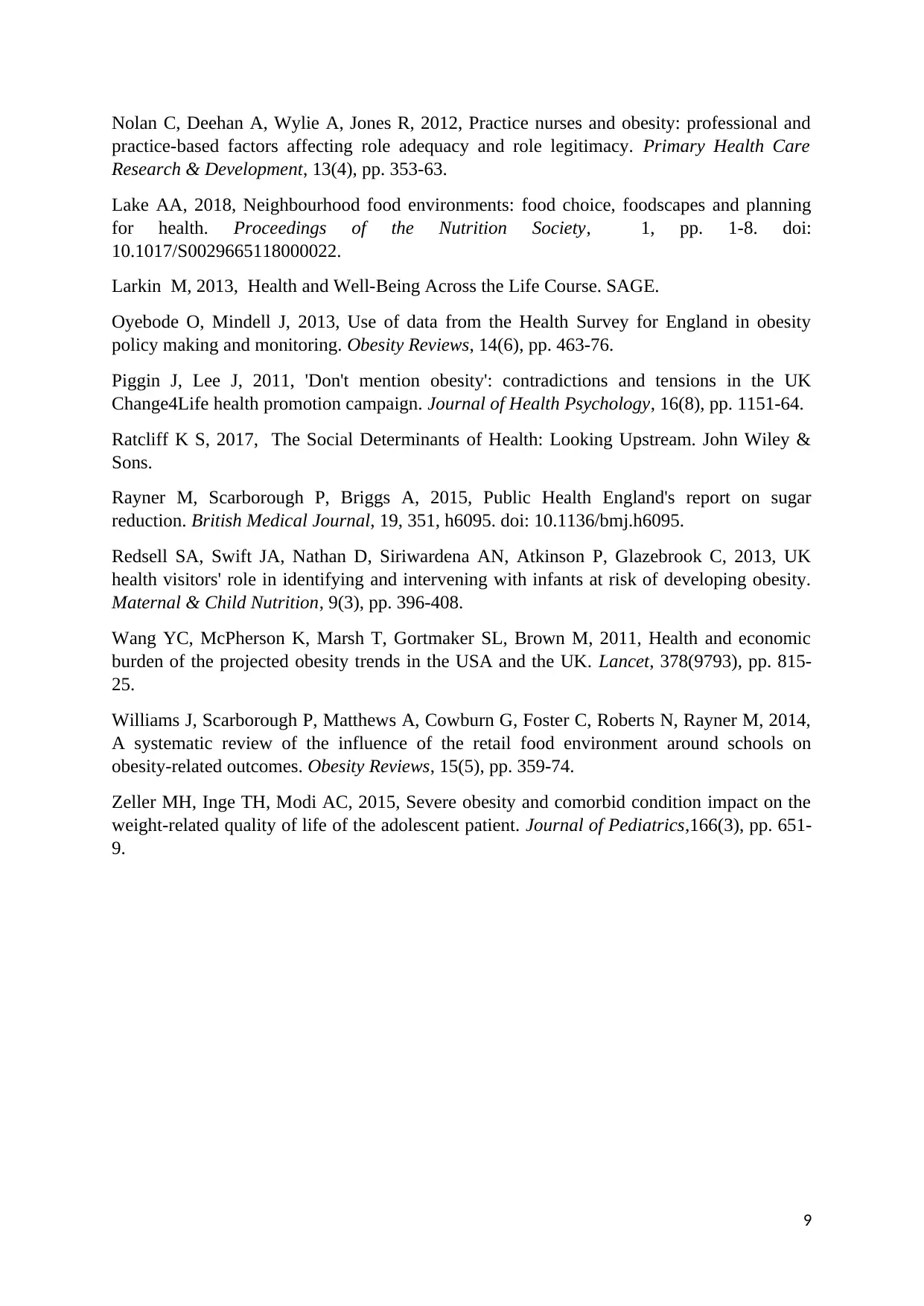
Nolan C, Deehan A, Wylie A, Jones R, 2012, Practice nurses and obesity: professional and
practice-based factors affecting role adequacy and role legitimacy. Primary Health Care
Research & Development, 13(4), pp. 353-63.
Lake AA, 2018, Neighbourhood food environments: food choice, foodscapes and planning
for health. Proceedings of the Nutrition Society, 1, pp. 1-8. doi:
10.1017/S0029665118000022.
Larkin M, 2013, Health and Well-Being Across the Life Course. SAGE.
Oyebode O, Mindell J, 2013, Use of data from the Health Survey for England in obesity
policy making and monitoring. Obesity Reviews, 14(6), pp. 463-76.
Piggin J, Lee J, 2011, 'Don't mention obesity': contradictions and tensions in the UK
Change4Life health promotion campaign. Journal of Health Psychology, 16(8), pp. 1151-64.
Ratcliff K S, 2017, The Social Determinants of Health: Looking Upstream. John Wiley &
Sons.
Rayner M, Scarborough P, Briggs A, 2015, Public Health England's report on sugar
reduction. British Medical Journal, 19, 351, h6095. doi: 10.1136/bmj.h6095.
Redsell SA, Swift JA, Nathan D, Siriwardena AN, Atkinson P, Glazebrook C, 2013, UK
health visitors' role in identifying and intervening with infants at risk of developing obesity.
Maternal & Child Nutrition, 9(3), pp. 396-408.
Wang YC, McPherson K, Marsh T, Gortmaker SL, Brown M, 2011, Health and economic
burden of the projected obesity trends in the USA and the UK. Lancet, 378(9793), pp. 815-
25.
Williams J, Scarborough P, Matthews A, Cowburn G, Foster C, Roberts N, Rayner M, 2014,
A systematic review of the influence of the retail food environment around schools on
obesity-related outcomes. Obesity Reviews, 15(5), pp. 359-74.
Zeller MH, Inge TH, Modi AC, 2015, Severe obesity and comorbid condition impact on the
weight-related quality of life of the adolescent patient. Journal of Pediatrics,166(3), pp. 651-
9.
9
practice-based factors affecting role adequacy and role legitimacy. Primary Health Care
Research & Development, 13(4), pp. 353-63.
Lake AA, 2018, Neighbourhood food environments: food choice, foodscapes and planning
for health. Proceedings of the Nutrition Society, 1, pp. 1-8. doi:
10.1017/S0029665118000022.
Larkin M, 2013, Health and Well-Being Across the Life Course. SAGE.
Oyebode O, Mindell J, 2013, Use of data from the Health Survey for England in obesity
policy making and monitoring. Obesity Reviews, 14(6), pp. 463-76.
Piggin J, Lee J, 2011, 'Don't mention obesity': contradictions and tensions in the UK
Change4Life health promotion campaign. Journal of Health Psychology, 16(8), pp. 1151-64.
Ratcliff K S, 2017, The Social Determinants of Health: Looking Upstream. John Wiley &
Sons.
Rayner M, Scarborough P, Briggs A, 2015, Public Health England's report on sugar
reduction. British Medical Journal, 19, 351, h6095. doi: 10.1136/bmj.h6095.
Redsell SA, Swift JA, Nathan D, Siriwardena AN, Atkinson P, Glazebrook C, 2013, UK
health visitors' role in identifying and intervening with infants at risk of developing obesity.
Maternal & Child Nutrition, 9(3), pp. 396-408.
Wang YC, McPherson K, Marsh T, Gortmaker SL, Brown M, 2011, Health and economic
burden of the projected obesity trends in the USA and the UK. Lancet, 378(9793), pp. 815-
25.
Williams J, Scarborough P, Matthews A, Cowburn G, Foster C, Roberts N, Rayner M, 2014,
A systematic review of the influence of the retail food environment around schools on
obesity-related outcomes. Obesity Reviews, 15(5), pp. 359-74.
Zeller MH, Inge TH, Modi AC, 2015, Severe obesity and comorbid condition impact on the
weight-related quality of life of the adolescent patient. Journal of Pediatrics,166(3), pp. 651-
9.
9
⊘ This is a preview!⊘
Do you want full access?
Subscribe today to unlock all pages.

Trusted by 1+ million students worldwide
1 out of 9
Related Documents
Your All-in-One AI-Powered Toolkit for Academic Success.
+13062052269
info@desklib.com
Available 24*7 on WhatsApp / Email
![[object Object]](/_next/static/media/star-bottom.7253800d.svg)
Unlock your academic potential
Copyright © 2020–2025 A2Z Services. All Rights Reserved. Developed and managed by ZUCOL.




